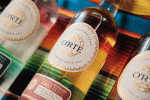Carson City vintner makes wine a work of art
CARSON CITY -- Red Metcalf claims to have the biggest vineyard in Carson City, and he probably is right.
With help from friends and family members, Metcalf become an amateur vintner with at least 128 flourishing grape vines in the backyard of his 2-acre property.
Metcalf is landlord with his son, Tom, of a leased building on Carson Street. He and his crew spent a week harvesting, crushing and fermenting this year's crop of grapes, and they spent part of last weekend bottling last year's harvest.
"I like it," Metcalf said after sampling his 2009 wine, "but I'm just playing with this because I'm retired. I'm not really a wine connoisseur. I generally don't drink more than three or four bottles a year. Two-buck Chuck is fine with me."
That might change soon. The folks out to help last Saturday worked for several hours filling 97 bottles with 2009 Red's Red Frontenac, a dry red varietal he said will be used for personal consumption, gifts and parties.
The wine will be stored for at least six months to get past bottle shock, which occurs immediately after bottling or when wines are transported.
For Metcalf, the venture is a lot of fun, and he always has a positive attitude.
"I figured that if we didn't get any good wine, we'd have a lot of really good vinegar," Metcalf said.
Metcalf would be first to admit it takes a village to nurture a vineyard and produce wine. He said that's just what happened over the past two years.
He also had a couple of expert assistants.
Russ Fiddyment was his agriculture specialist, a friend with a master's degree in plant pathology.
Fiddyment pointed out the fickle nature of wine.
"All that (education) doesn't make a heck of a bit of difference in wine making," he said.
Metcalf's other specialist was Mike Hautekeet of Mike's Pharmacy, with his pharmaceutical skills.
"Wine making is almost like working in a pharmacy, but it tastes a lot better than medication," he said.
How does someone in Northern Nevada decide to become a vintner?
Metcalf moved to his Carson City property seven years ago. When he had the backyard landscaped four years ago, he still had quite a bit of land left over.
"Tom said, 'Why don't you plant some grapes?' and I thought I'd give it a try," Metcalf said. "I had the landscapers set it up for vines, and I bought 128. I talked with the folks at the Tahoe Ridge Winery in Genoa for recommendations."
The Frontenac grapes Metcalf grows are from hardy vines that can withstand winter temperatures as low as minus-40 degrees, and they do not need a lot of water.
"The first year, you plant, and the second year, you pinch off the grapes to help build up the vines," he said
He has lost a couple of vines over the years. But he easily started new sprouts from cuttings, and several other vines have come back on their own after appearing to have died.
"I'm not an experienced enough vintner to expect much. I keep it watered and weeded and listen to the advice from friends and pick up what I read in books, even though everything you read says that everyone's got their own opinions and methods. There are just too many variables like weather and soil."
When the grapes begin to ripen, all the vines are covered with netting to protect them from birds, and shortly thereafter comes the harvest.
Tom Metcalf was enthusiastic about the family venture.
"We harvested 438 pounds last year; and even though there was less poundage this year, there was more volume because the grapes were bigger and healthier, so we'll get more wine out of less poundage," he said.
After harvesting, the grapes are de-stemmed and crushed to release the juice, then scooped into a barrel with seeds and skins where it will turn into "must" through fermentation.
Sulphur is added to kill bacteria. Then, a day later, yeast is added to turn the grape sugar into alcohol.
Carbon dioxide causes the must to rise as much as 4 inches. A foamy cap is stirred down a couple of times a day over the course of about a week. The carbon dioxide production decreases once the fermentation process is nearly complete.
From there, the wine is scooped into a press to produce a pure juice for storage in "carboys," 5-gallon jars fitted with a fermentation trap to release the gases. Oak chips are available for flavoring since most amateur vintners don't have access to oak barrels.
The Metcalfs rent their crusher and presser for $25 each.
The full carboys are stored in a 56-degree, temperature-controlled unit for a year, and "racked" three times, which consists of siphoning the wine off of the "lees," or sediment that settles in the bottles. The wine then goes into clean carboys.
"You just throw the stuff at the bottom away," Hautekeet said. "Every time you rack it, it becomes more clear. It ages, and then it's ready for bottling."
When it's time to bottle, the contents of the carboys are poured into a 25-gallon drum and the bottling begins. The Metcalfs used a three-bottle bottler. Once they got going, they filled and corked 97 bottles in less than 30 minutes.
The Metcalfs use a heat gun and shrink wrap to cover the cork, and their label design is still being refined.
"It's very technical, but at the same time, it's an art form," Metcalf said.























